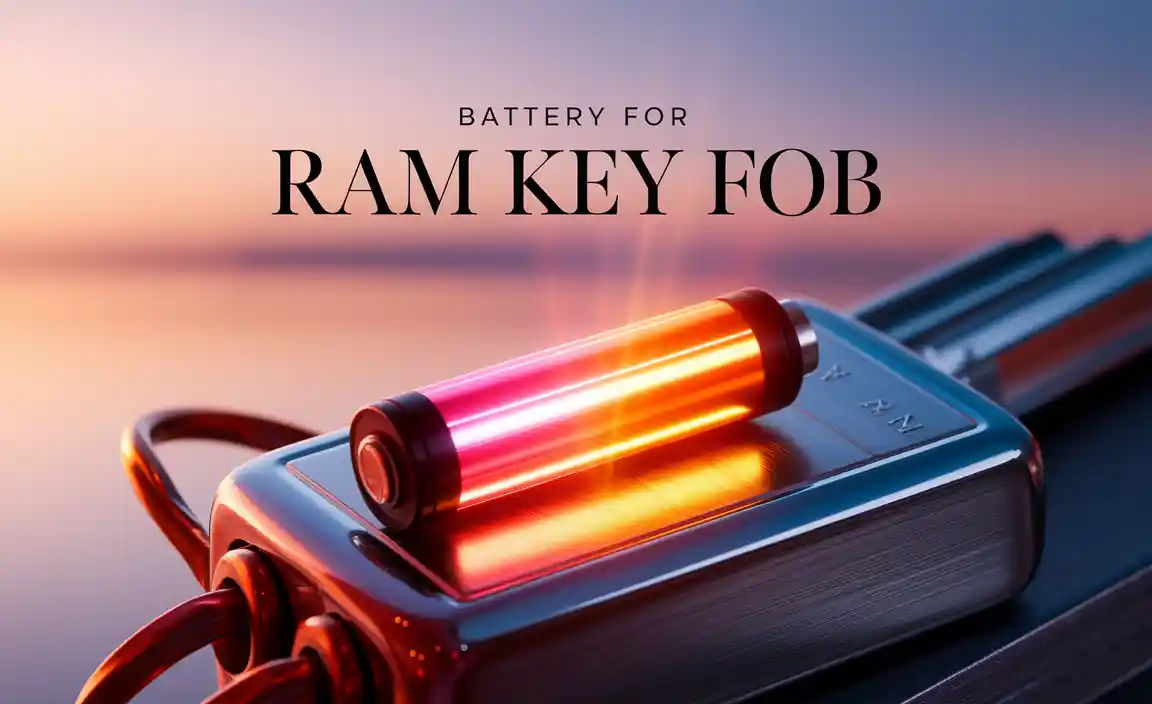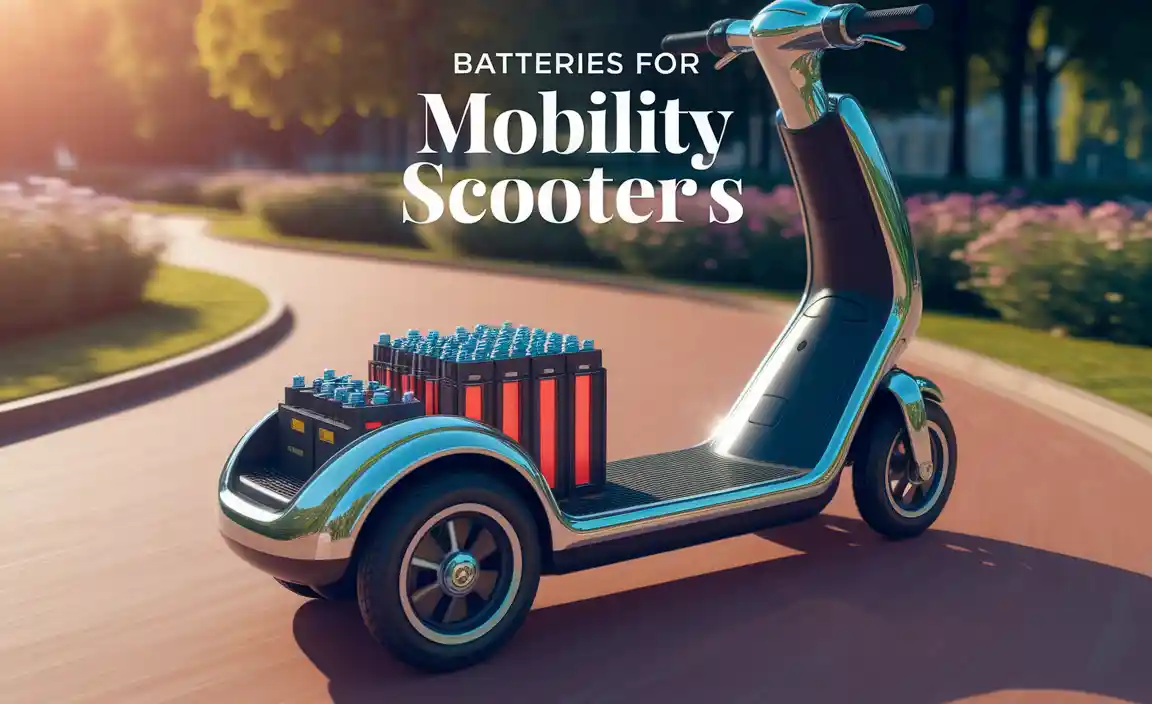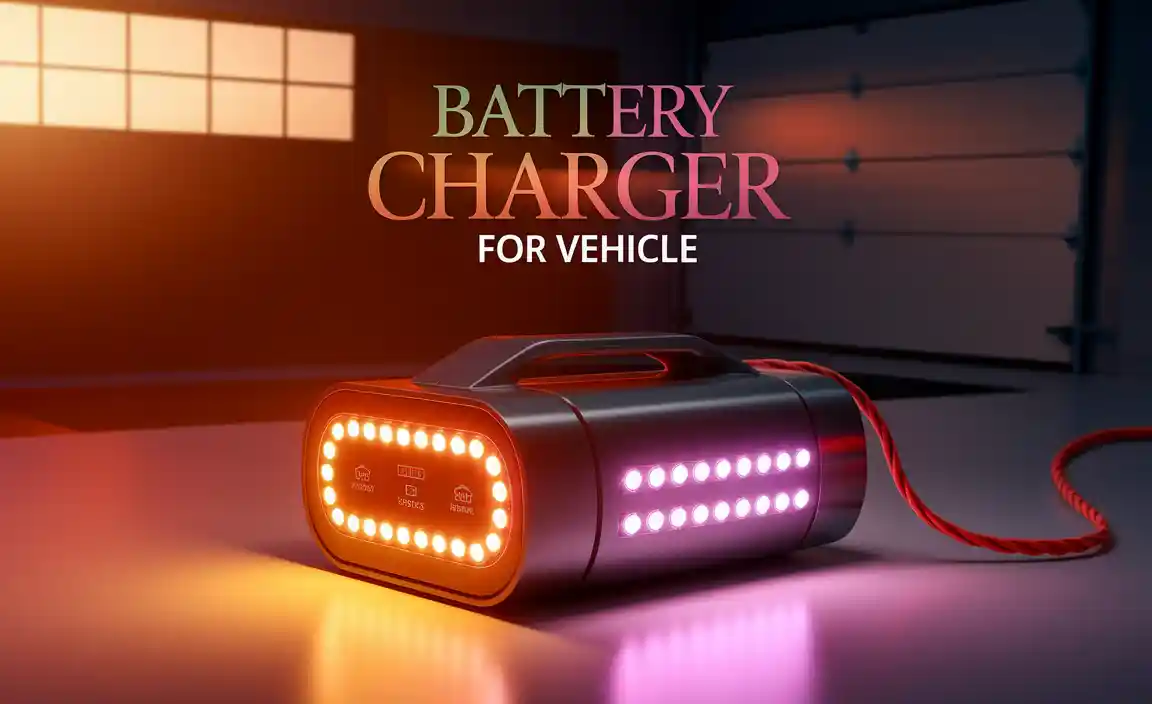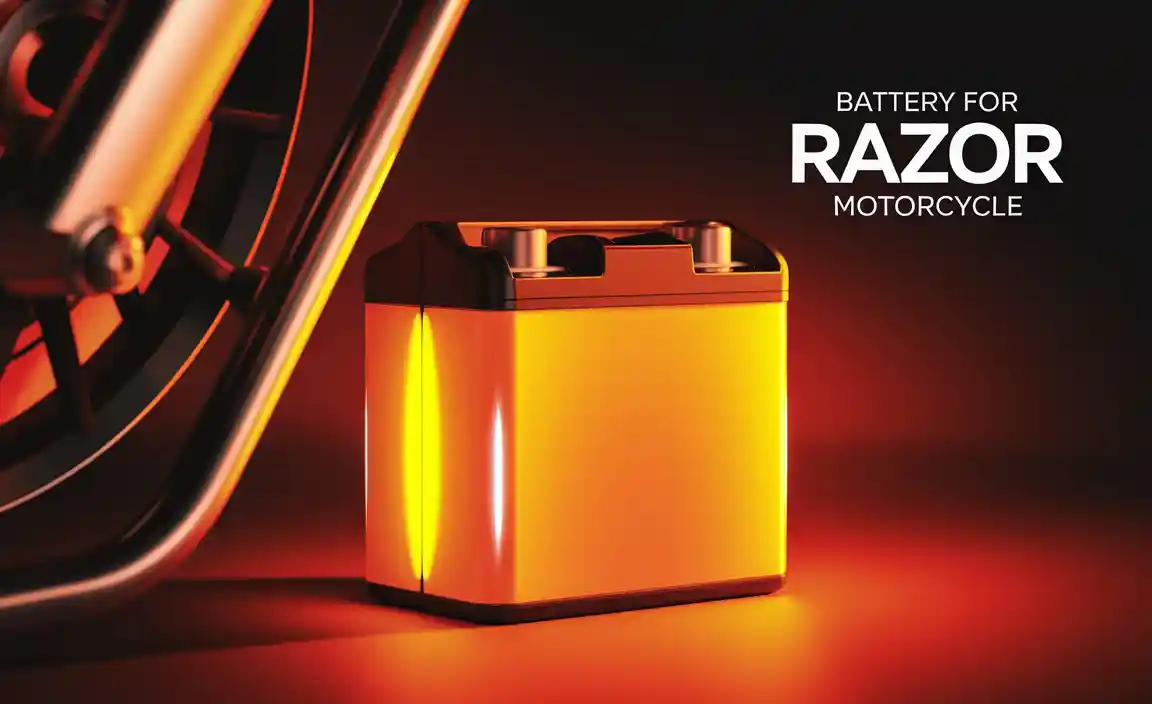Quick Summary: When you compare 12v car battery for trucks, look for Cold Cranking Amps (CCA) suitable for your climate, reserve capacity for power needs, and physical size. Ensure it matches your truck’s original specifications for a reliable fit and optimal performance, keeping safety and longevity in mind.
Is your truck battery acting up? We’ve all been there – a slow crank, a dead battery on a cold morning, or wondering if it’s time for a change. It can feel like a big, confusing job, right? But don’t worry, it doesn’t have to be! Understanding your truck’s 12-volt battery is simpler than you might think. Think of me, Roy Walker, as your friendly guide. I’ll break down exactly what you need to know when you compare 12v car battery for trucks. We’ll cover everything from what makes a good battery to how to pick the right one for your specific needs. Get ready to feel confident about keeping your truck powered up and ready to go!
Why Choosing the Right 12v Truck Battery Matters
Your truck’s battery is the heart of its electrical system. It’s not just for starting the engine; it powers everything from your headlights and radio to your truck’s computer and safety features. When you need to compare 12v car battery for trucks, making the correct choice ensures your truck runs smoothly, reliably, and safely. A weak or incorrect battery can lead to frustrating breakdowns, especially in tough weather conditions or when you need your truck the most.
For trucks, especially those that might be used for towing, hauling, or in demanding climates, the battery needs to be robust. It’s got a tough job to do, and the right 12-volt battery is built to handle it. We’ll dive into the key features that make a difference, so you can confidently pick a battery that’s a perfect fit for your truck and your lifestyle.
Understanding the Basics: What is a 12v Car Battery?
A 12-volt (12v) car battery is a rechargeable battery that supplies the initial burst of energy needed to start your truck’s engine. Once the engine is running, the alternator takes over to power the vehicle and recharge the battery. This 12v system is standard in most cars and trucks, making it a familiar component. The “12v” refers to the nominal voltage, or electrical potential difference, between the positive and negative terminals of the battery.
Inside, a typical 12v lead-acid battery consists of six cells, each producing around 2 volts, totaling roughly 12.6 volts when fully charged. These cells are filled with a mixture of lead plates and an electrolyte solution. The chemical reaction between the lead plates and the electrolyte generates the electrical current. Understanding this basic structure helps demystify what you’re looking at when you compare 12v car batteries for trucks.
Key Features to Look for When You Compare 12v Car Battery for Trucks
When you’re shopping for a new battery, you’ll see a lot of numbers and terms. Let’s break down the most important ones so you can easily compare 12v car batteries for trucks:
1. Cold Cranking Amps (CCA)
This is arguably the most critical rating for truck batteries, especially if you live in a cold climate. CCA measures how much power the battery can deliver in freezing temperatures (0°F or -18°C) for about 30 seconds while maintaining a minimum voltage. More CCA means a stronger start in the cold.
- Why it matters for trucks: Trucks often have larger engines that require more power to turn over, especially when cold.
- What to look for: Check your truck’s owner’s manual for the manufacturer’s recommended CCA rating. Always aim for a battery with at least the recommended CCA, or slightly higher if you consistently drive in very cold weather.
2. Reserve Capacity (RC)
Reserve capacity tells you how long a fully charged battery can supply a certain amount of power (typically 25 amps) before its voltage drops to a usable level (10.5 volts). This is important for accessories that might run when the engine is off, like lights or a stereo for a short period.
- Why it matters for trucks: If you use your truck’s electronics with the engine off, or if you find yourself stuck in traffic with accessories running, a higher RC provides more buffer.
- What to look for: A longer reserve capacity means more staying power. Aim for a battery that meets or exceeds your truck’s original equipment (OE) specifications.
3. Age and Date Code
Batteries degrade over time, even when unused. You’ll often find a sticker on the battery with a code indicating when it was manufactured. This code usually involves a letter for the month (A=January, B=February, etc.) and a number for the year.
- Why it matters: You don’t want to buy a battery that’s already been sitting on the shelf for a year. A fresh battery will last longer and perform better.
- What to look for: Try to find a battery manufactured within the last 6 months. Avoid batteries older than a year.
4. Physical Size and Terminal Type
Batteries come in different physical dimensions and with different terminal layouts (where the positive and negative posts are located). It’s crucial that the new battery fits securely in its tray and that the cables can reach the terminals comfortably.
- Why it matters: A battery that’s too big won’t fit, and one that’s too small might not be securely held, which is a safety hazard. Incorrect terminal placement means your cables won’t connect.
- What to look for: Battery Group Sizes are standardized (e.g., Group 24F, Group 35, Group 65 for trucks). Check your owner’s manual or measure your current battery and its tray to determine the correct group size. Also, note the orientation of the positive and negative terminals.
5. Battery Technology (Incomplete comparison, but necessary for context)
While most truck batteries you’ll encounter are standard flooded lead-acid batteries, some might be Enhanced Flooded Batteries (EFB) or Absorbed Glass Mat (AGM) batteries. AGM batteries are more advanced, offering better vibration resistance, deeper cycle capability, and more efficient charging. They are often recommended for trucks with start-stop technology or high electrical demands.
- Why it matters: If your truck has specific features like start-stop or high-tech accessories, an AGM battery might be a better, albeit more expensive, choice.
- What to look for: Decide if your truck’s needs warrant an AGM or EFB battery, or if a standard flooded battery will suffice. Your owner’s manual is the best place to find this information.
Comparing Different Types of 12v Truck Batteries
When you compare 12v car battery for trucks, you’ll primarily be looking at variations of the lead-acid design. Here’s a quick rundown:
Standard Flooded Lead-Acid Batteries
These are the most common and generally the most affordable. They require occasional maintenance, such as checking and topping up the electrolyte levels with distilled water. They are reliable workhorses for many applications.
- Pros: Cost-effective, widely available, good performance for everyday use.
- Cons: Can be sensitive to vibration, requires some maintenance, may not handle deep discharges as well as other types.
Enhanced Flooded Batteries (EFB)
EFB batteries are an upgrade from standard flooded batteries, offering better performance, especially in vehicles with start-stop systems or higher electrical demands. They have a stronger internal structure to handle more frequent charging and discharging cycles.
- Pros: Better than standard flooded for start-stop, more resistant to deep discharge cycles.
- Cons: More expensive than standard flooded, not as robust as AGM for very high demands.
Absorbed Glass Mat (AGM) Batteries
AGM batteries use a special absorbent mat to soak up the electrolyte. This design makes them spill-proof, highly resistant to vibration, and capable of handling deeper discharge cycles. They are often the OE (Original Equipment) battery in many newer vehicles with advanced features.
- Pros: Excellent vibration resistance, spill-proof, deep cycle capability, fast charging, maintenance-free.
- Cons: Most expensive option, can be damaged by overcharging if not followed by the correct charging system.
For most standard trucks, a high-quality flooded lead-acid will do the job. If your truck has start-stop technology or you frequently use many accessories with the engine off, consider EFB or AGM. Always check your owner’s manual to see what the manufacturer recommends.
How to Find the Right Battery Group Size
This is where we get practical. Getting the right physical fit is crucial. Battery manufacturers use a Group Size system to standardize physical dimensions and terminal placement. Failing to get the right group size can mean a battery that simply won’t fit, or worse, one that’s not secure.
Steps to Determine Your Truck’s Battery Group Size:
- Check Your Owner’s Manual: This is the easiest and most reliable method. The manual will explicitly state the recommended battery group size for your make and model.
- Examine Your Current Battery: Look for a sticker or an embossed number on the side of your existing battery. It will typically say something like “Group 65,” “Group 35,” or “Group 78.”
- Measure: If you can’t find the size on the battery or in the manual, you can measure your battery tray. Note the length, width, and height. Also, pay attention to where the positive and negative terminals are located (e.g., positive on the left, positive on the right when looking at the terminals). You can then use these measurements to compare with battery specifications.
- Consult Online Resources: Many auto parts stores and battery manufacturers have online tools where you can input your truck’s year, make, and model to find compatible battery group sizes and specific battery models.
It’s important to remember that older trucks might have different battery requirements than newer ones. Always prioritize the information in your owner’s manual.
Important Safety Tips for Handling Car Batteries
Batteries contain corrosive acid and can produce flammable gases. It’s essential to follow safety precautions when handling them. I always say, a little caution goes a long way!
Safety First!
- Wear Safety Glasses and Gloves: Protect your eyes from potential splashes of battery acid and your hands from both acid and grime.
- Work in a Well-Ventilated Area: Batteries release hydrogen gas, which is flammable. Ensure good airflow to prevent gas buildup.
- Avoid Sparks and Flames: Keep open flames, cigarettes, and anything that could cause a spark away from the battery.
- Handle with Care: Batteries are heavy! Lift with your legs, not your back. They are also delicate; dropping one can cause internal damage or cracks, leading to leaks.
- Keep Metal Objects Away: Do not let tools or other metal objects touch both battery terminals at the same time, as this can create a short circuit and cause sparks or damage.
- Disconnect Properly: Always disconnect the negative (-) cable first, then the positive (+). When reconnecting, attach the positive (+) cable first, then the negative (-). This prevents accidental short circuits.
If you’re unsure about any step, especially when dealing with battery removal or installation, it’s always best to consult a professional or have a knowledgeable friend help you. For more detailed information on battery safety, resources like the U.S. Environmental Protection Agency (EPA) provide guidance on handling and recycling lead-acid batteries responsibly.
Replacing Your Truck Battery: A Simple Step-by-Step Guide
Replacing a truck battery can seem daunting, but it’s a manageable DIY task if you’re careful. Here’s how to do it, step by step:
What You’ll Need:
- New 12v truck battery (correct group size)
- Wrench set (typically 10mm or 13mm for most battery terminals)
- Wire brush or battery terminal cleaner
- Battery terminal protector spray (optional)
- Gloves and safety glasses
- A small towel or rag
Step-by-Step Replacement:
- Park Safely: Park your truck on a level surface, engage the parking brake, and turn off the engine. Open the hood.
- Locate the Battery: The battery is usually found under the hood, often towards the front or side.
- Disconnect the Cables (Safety First!): Using the correct wrench, loosen and remove the black negative (-) cable first. Then, loosen and remove the red positive (+) cable. Move the cables away from the battery terminals so they can’t accidentally touch them.
- Remove the Hold-Down Clamp: Most batteries are secured by a clamp or bracket at the base or over the top. You’ll need to loosen and remove the bolts or nuts holding this clamp in place. Keep track of these small parts!
- Lift Out the Old Battery: Carefully lift the old battery straight up and out of the tray. Remember, batteries are heavy! If it’s difficult, double-check that all clamps are removed.
- Clean the Tray and Cables: Use your rag to clean out any corrosion or debris from the battery tray. Use the wire brush or a battery cleaning tool to clean the cable terminals until they are shiny. This ensures a good connection.
- Install the New Battery: Carefully place the new battery into the tray, making sure it sits securely.
- Reinstall the Hold-Down Clamp: Secure the new battery with the hold-down clamp and tighten the bolts or nuts. Make sure the battery is firmly in place and won’t move.
- Connect the Cables (Order is Important!): Attach the red positive (+) cable to the positive terminal first. Tighten it securely. Then, attach the black negative (-) cable to the negative terminal and tighten it.
- Apply Terminal Protector (Optional): Spray a corrosion-resistant protector onto the terminals to help prevent future buildup.
- Close the Hood and Start Up: Close the hood, start your truck, and make sure everything is working correctly. Your new battery should provide a strong crank!
Don’t forget to properly dispose of your old battery! Most places you buy a new battery will accept your old one for recycling, or you can take it to a local recycling center. Many retailers offer a core charge refund when you return the old battery.
When to Consider Upgrading Your Truck Battery
While replacing your battery with the same type and specifications is standard, there are times when an upgrade makes sense:
- Heavy-Duty Use: If you frequently tow, haul heavy loads, or use your truck for work (e.g., construction, commercial driving), a higher CCA or RC battery can provide more consistent power.
- Harsh Climates: Living in an area with extreme cold or heat puts extra strain on batteries. A battery with a higher CCA rating is especially beneficial in cold climates.
- Added Electronics: If you’ve installed aftermarket accessories like a powerful stereo system, winches, extra lighting, or a robust navigation system, an upgraded battery (possibly an AGM) with greater capacity can handle the increased electrical load.
- Start-Stop Technology: Many modern trucks with fuel-saving start-stop systems require EFB or AGM batteries that can handle frequent engine restarts and deeper discharge cycles better than standard flooded batteries.
- Deeper Cycle Needs: If you often camp in your truck and rely on the battery to power lights, refrigerators, or other accessories for extended periods with the engine off, a battery designed for deep cycling (like some AGM models) would be a wise investment.
When considering an upgrade, always ensure the new battery’s physical dimensions and terminal configuration are compatible with your truck’s mounting and cabling. Consult your owner’s manual or a trusted mechanic about any potential compatibility issues.
Battery Maintenance and Longevity Tips
Taking good care of your truck’s battery can extend its life and ensure reliable performance. Even maintenance-free batteries benefit from a little attention.
Simple Maintenance Practices:
- Keep Terminals Clean: Regularly check for corrosion (a white, powdery substance) on the battery terminals. Clean them with a wire brush and a mixture of baking soda and water. Ensure they are dry and then reapply a terminal protector if desired.
- Ensure Secure Fit: Make sure the battery is tightly held in its tray. A loose battery can be damaged by vibrations, leading to premature failure.





